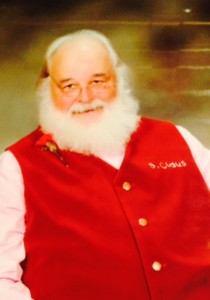
It’s Really Me..SantaMontana

S Claus SantaMontana
I am an actor when I portray SANTA. I am totally consumed by the role I portray. I give my very best to become the character through the eyes of all those who see me as the jolly ole man himself.
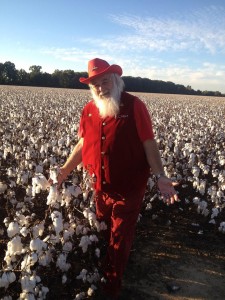
Way down South in Dixie
History of Santa Claus in America
Learn the History of Santa Claus through our study of the references to Santa Claus in American Literature. We have researched the phrases Santa Claus and Saint Nicholas from the 17th century through the 20th century so that everyone may better understand the History of Santa Claus.
The modern American image of Santa Claus as the jolly round man in the Professional Santa Claus Suit who slides down the chimney on Christmas Eve leaving gifts to the good little boys and girls is one of the most popular children’s tales. Nearly every American has celebrated the tradition but few know the origins of the custom, apart from the stories of their youth or holiday conversations.
Early Americans did not imagine the Santa Claus that we know today. The earliest written account in America of someone resembling Santa Claus is Washington Irving’s satire of Dutch culture titled History of New York, which was first published in 1809. In chapter IX, Irving writes “At this early period . . . hanging up a stocking in the chimney on St. Nicholas eve . . . is always found in the morning miraculously filled; for the good St. Nicholas has ever been a great giver of gifts, particularly to children.”
This passage is a reference to the Dutch tradition of celebrating Saint Nicholas Eve, the night when Sinterklaas, the Dutch name for Saint Nicholas, fills children’s shoes with small gifts. This celebration has a long history in the Netherlands immortalized by the Jan Steen painting The Feast of St. Nicholas dating back to the 17th century. For early Dutch-Americans, Saint Nicholas, the patron Saint of children, was characterized as a thin, stately, stern, forgiving person with a white beard and Bishop robe who was as likely to dispense discipline as leave gifts.
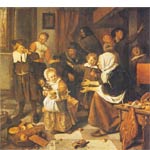 The Feast of St. Nicholas by Jan Havicksz Steen, 1663-1665.
The Feast of St. Nicholas by Jan Havicksz Steen, 1663-1665.
Although Washington Irving’s Dutch Saint Nicholas is the first published account of a holiday gift giver in America, there are more differences than similarities between Saint Nicholas and the modern Santa Claus. Saint Nicholas is a Bishop whereas Santa Claus is a secular figure. Saint Nicholas is a thin, stern person while Santa Claus is a round and jovial one. The Saint Nicholas Costume is a religious Bishop robe similar to a Victorian Santa Suit. This costume bears little resemblance to the modern Santa Claus Suit, except for its red color. And, Saint Nicholas Eve is December 5th whereas the modern Santa Claus delivers his toys on the evening of December 24th. Perhaps the only similarity, apart from his white beard and the color of his clothes, is that the Dutch name for Saint Nicholas, Sinterklaas, sounds quite surprisingly like Santa Claus.
While the History of New York depicts the Dutch American tradition of Saint Nicholas Eve, the first modern American description of a jovial fellow giving gifts to children on Christmas Eve is an anonymous poem titled Account of A Visit from St. Nicholas. This poem, published on December 23, 1823 in the Troy, New York newspaper The Sentinel, is better known as the The Night Before Christmas. It was later attributed to Clement Clarke Moore but there is some controversy about the authorship, as the descendents of Henry Livingston, Jr. believe that their ancestor wrote the poem.
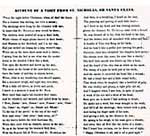 Representation of Account of a Visit from St. Nicholas, 1823.
Representation of Account of a Visit from St. Nicholas, 1823.
From the first line of the poem, “Twas the night before Christmas”, the celebration is recast from Saint Nicholas Eve on December 5th to Christmas Eve on December 24th. The poem transforms the physical appearance and demeanor of Saint Nicholas from a thin, religious figure to a portly, secular one in the phrases “He had a broad face and a little round belly” and “He was chubby and plump, a right jolly old elf”. The author diminishes the religious characteristics of our gift giver referring to him as an “elf” and using his name in slang for the first time in the phrase “it must be St. Nick”. Plus, the poem discards the religious Bishop clothing in favor of a more modern Santa Claus Suit in the phrase “dress’d all in fur, from his head to his foot”.
This poem offers some of the first significant written details surrounding the story of Saint Nicholas. We know how the gifts were brought into the house in the phrase “Down the chimney St. Nicholas came with a bound”. And, the poem says that he had a “sleigh full of Toys” and “eight tiny rein-deer”. The reindeer names were quite different than those of the modern Santa Claus as the poem says “Dunder and Blixem” rather than Donner and Blitzen. This is probably because of the Dutch influence on the holiday, as Dunder is thunder and Blixem is lightning in Dutch.
Whereas Irving and Moore depicted the famous gift giver under the name Saint Nicholas, the first historical account using the name Santa Claus are the illustrations of the political cartoonist Thomas Nast. In the January 3, 1863 edition of Harpers Weekly, Thomas Nast illustrated the first published image of Santa Claus in his political carton titled Santa Claus in Camp. Not only is the name Santa Claus in the title of the piece but there is a banner drawn in the picture that says “Welcome Santa Claus” as well.
Nast defines the modern image of Santa Claus, as his cartoon portrays him in a Professional Santa Suit Costume of fur trimmed coat, pants and hat. This Santa Outfit is drawn with a patriotic stars and stripes design rather than the modern red and white colors, as the motive for this cartoon was political. Not only does the Nast cartoon secularize the celebration with the patriotic colors of the Santa Suit but it further removes the religious aspect of the celebration by calling the gift giver Santa Claus, not Saint Nicholas. This cartoon also suggests that the holiday is no longer solely for children, as there are adult soldiers receiving gifts in the cartoon. One of the men is shown receive a gift of socks, which would have been a great favor for a soldier.
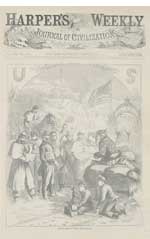 Santa Claus in Camp, Thomas Nast, 1863.
Santa Claus in Camp, Thomas Nast, 1863.
Later illustrations by Nast such as his 1865 drawing titled Santa Claus would further refine the image of Santa Claus to the modern likeness as the Santa Suit changes to the more traditional solid color jacket, pants and hat all trimmed with fur. The gift giving of his later cartoons also focuses on more traditional gifts such as a doll for a girl and a trumpet for a boy.
By the middle of the 19th century, the story of Santa Claus is fairly well established. We know that he is a plump, jolly man with the name Santa Claus. He wears a fur trimmed jacket, pants and hat like the modern Santa Claus Suit. He brings the gifts on a sleigh pulled by eight reindeer and delivers them on Christmas Eve, even though the celebration is not necessarily religious in nature. This is the essence of the tale.
Later writers would add significant detail to the story of Santa Claus. For example, Lyman Frank Baum, best known for writing The Wizard of Oz, wrote the children’s story The Life and Adventures of Santa Claus first published in 1902. This wonderful tale illustrates how Santa Claus could be human, deliver toys to millions of children and live forever. The story offers the first logical, albeit fantasy explanation for the origins of the celebration. An interesting aspect of Baum’s tale is that it makes an effort to explain that the timing of Santa Claus delivering toys and the Christian holiday celebrating the birth of Jesus are coincidence, asserting that the toy-giving Santa Claus is a secular event.
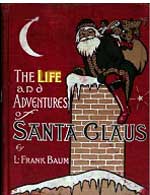 The Life and Adventures of Santa Claus, L. Frank Lyman, 1902.
The Life and Adventures of Santa Claus, L. Frank Lyman, 1902.
What began as a Dutch tradition originating from the religious-oriented celebration of Saint Nicholas Eve ultimately became transformed into an American secular holiday. Today’s children probably owe the early Dutch Americans a great deal of gratitude for bringing the forefather of Santa Claus with them. Without the Dutch childrens “visions of sugar plums”, today’s young Americans might not find an Xbox or Wii on Christmas day.
Bibliography
Irving, Washington. History of New York. Philadlephia, Inskeep and Bradford, 1809.
Steen, Jan Havicksz. The Feast of St. Nicholas. Netherlands, Rijksmuseum, 1663-1665.
Moore, Clement Clarke. Account of A Visit from St. Nicholas. ‘The Sentinel’, Troy, New York, 1823.
Nast, Thomas. Santa Claus in Camp. ‘Harpers Weekly’, New York, Harpers Magazine Co., 1863.
Baum, L. Frank. The Life and Adventures of Santa Claus. Indianapolis, Bowen-Merrill Co., 1902.
Believe it or not!
“Xmas” came into general use from the church! X is the Greek letter Chi, which is the first letter of Christ’s name in –so “Xmas” is every bit as religious as “Christmas.”
The cross so overshadowed the manger-and the resurrection so overshadowed the incarnation-that neither scripture nor tradition has passed down a firm date for Christmas.
Christmas didn’t gain widespread recognition among Christians until quite recently. In some protestant-dominated areas, such as the Massachusetts Bay Colony, the celebration of Christmas was even legally banned!
As late as the last century, Christmas wasn’t even a legal holiday! This explains why nineteenth-century readers found it credible that Scrooge could require Cratchit to come to work on Christmas Day and why in the nineteenth century the US Congress could meet on Christmas Day.
Alabama was the first in 1836.
A caroling we will go!
Christmas carols began as an old English custom called “wassailing,” in which one would toast their neighbors to a long life. So when you sing Christmas carols, you’re bringing joy AND wishing good health to everyone you come across!
“Jingle Bells” was originally written for a Thanksgiving Celebration.
It was also the first song to be sung in space–on December 16, 1965 by astronauts Tom Stafford and Wally Schirra.
After “A Christmas Carol,” Charles Dickens wrote other Christmas stories annually–although none would be as successful as the first.
Santa Claus is Comin’ to Town!
Due to international time zones, our modern day Santa Claus actually has 31 hours to deliver presents to all the children of the world.
But to do so, he’ll need to travel at a rate of 4,796,250 MPH! So that’s how he does it!
Saint Nicholas Day (December 6) was the traditional day for giving gifts to children. It is still the day on which children receive gifts from St. Nicholas in the Netherlands.
Santa Claus is the American pronunciation of Sinter Klaas, which was colloquial Dutch for Saint Nicholas.
Christmas Tree, Oh Christmas Tree…
The Christmas tree is a Christianized pagan custom that originated in Germany. German settlers introduced it in America. It became popular during the nineteenth century, and then later spread to Britain and Japan from the US.
The world’s largest Christmas tree was a Douglas Fir standing 221 feet tall! It was displayed at the Northgate Mall right here in Seattle in 1950. We sure know how to do Christmas right in the Pacific Northwest! Can you imagine all the tinsel?
Franklin Pierce was the first president to place a Christmas tree in the White House.







